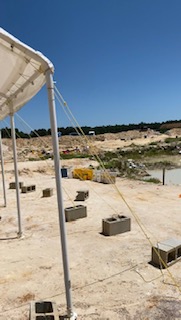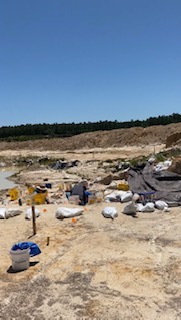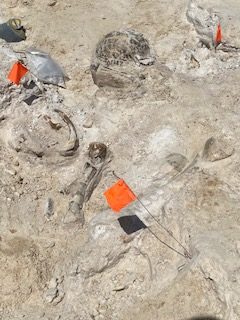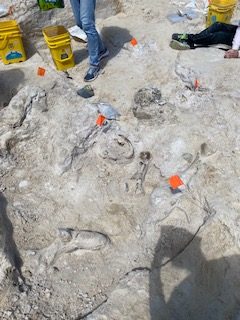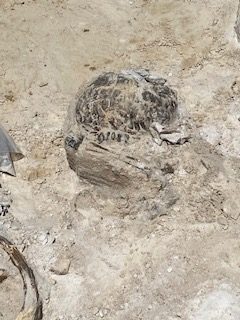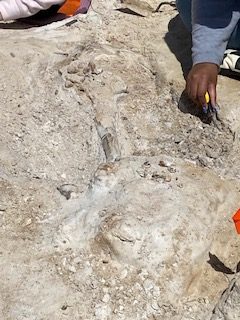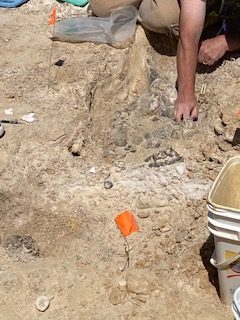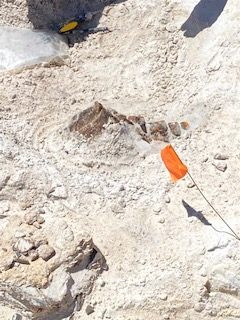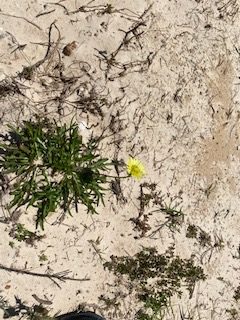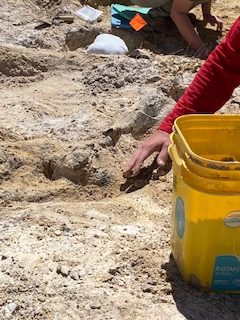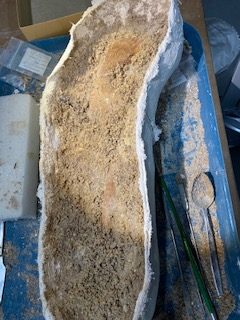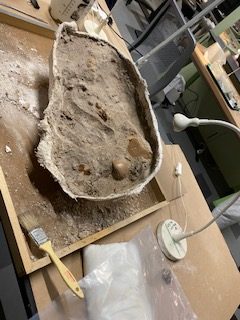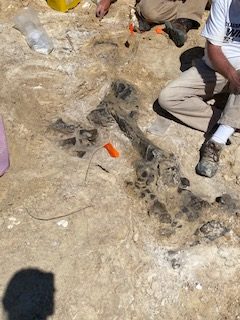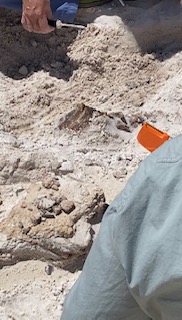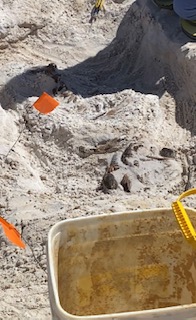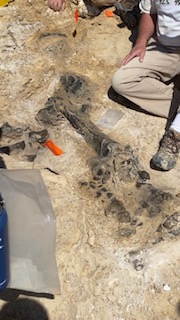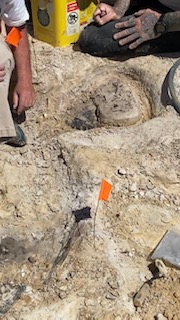Day 1: February 19, 2022
When I first got to the site, it was a nice, breezy day. I was actually a little chilly, so I brought a jacket. The sun eventually came out, but the weather remained temperate. My first impression of the site was that it wasn’t what I imagined. I thought it was going to be a little larger than it was, but still a fascinating site.
I was placed in a higher up square off to the left of the grid. The way the site is sectioned is by 1-meter squares with flags to keep track of fossil locations. The volunteers, workers, and students work in these 1-meter squares to level the site out, so it won’t be difficult to remove a fossil if found.
Once placed, I started digging and leveling out my square. I didn’t find much that day, maybe one piece of fossilized excrement. It was really funny to pull it out and find out it was that; I really thought I pulled out something great. (Which, I mean, it’s still pretty cool to find). The level I was digging from was a higher level than the sediment, probably still sand or so.
The hardest thing was probably sitting the square with my back bent for so long. Once I got back in my car my back hurt so bad. I ended up switching positions a few times during my time out there.
I think the most fun thing about being out there was digging with my friend and listening to all the stories that Dr. Jonathan Bloch was telling everyone.
Day 2: March 27, 2022
Day 2 was a little more exciting than my first dig day. I actually ended up finding pieces of turtle shell! I couldn’t believe my eyes; to find a big fossil like that. I actually ended up finding the fossil later on in the dig day, but I was still able to remove it all. Speaking of removing it, I was SO NERVOUS to remove the fossil. When Dr. Richard Hulbert told me to remove the fossilized turtle shell, I remembered staring at it for a while and removing so much sand around it so I can try to get it out in one piece. I believe that the shell was pieces of turtle peripheral.
I really tried my best but ended up cracking the fossil. I felt so terrible, but everyone reassured me that these things happen. That day was a lot of fun as well, because I got to talk to a lot of my classmates who were digging that day.
Other than the turtle fossil, I didn’t find anything significant. However, my classmates were finding lots of turtle bones as well.
Day 3-4: April 9-10
So, these days were jam-packed with so much stuff! We found the ulna of a Gomphothere or a Mastodon, a complete turtle shell, a bird bone, a Rhino Jaw, and so much more.
April 9 was a very windy day. To the point where, when I got home, when I wiped my forehead, all I felt was the sand particles. We actually had to take the tent down because it looked like it was about to fly away. This day was another day where I didn’t find anything, mainly just leveled off the square.
That day I ended up digging on the other side of the site, which is where there was a lot uncovered fossils already and ready to be plaster jacketed. There was a humerus, a femur, the complete turtle shell, and a piece of rib.
On the other side of the site is where we discovered the ulna of the elephant ancestor. Everyone was so amazed because it was already an amazing species to uncover.
April 10 is when we discovered even more fossils as well as uncovering even more of the ulna. One volunteer even found a bird bone, which was very rare compared to other things we find at the site.
On the other side of the site, another volunteer found a Rhino Jaw. The way to tell if you found fossilized teeth is if it is a brownish-orange color. It was really interesting to see because this find is also rare compared to the other fossils; this recent find was the fourth one discovered at the site.
Also, one of the students ended up plaster jacketing a fossil out there, which that was also impressive to watch the process happen.
I ended up finding some small bones as well as some Gar scales, which I never saw before, so I was impressed when I found a few of them digging out there.
Laboratory Day at Museum
This was probably the most fun that I had during my experience because of all the interactions from the interested parents and children alike. I decided to prepare a plaster jacket. I ended up working on an alligator jaw. However, to my surprise, I also uncovered the bottom side of a snapping turtle shell.
The volunteer uncovering an alligator next to me was also very pleasant to work with, she was very knowledgeable, and we also had great side conversations.
During my time at the laboratory, three people came into the exhibit and presented a fossil from a river in Florida. Richard said it was the root of a Gomphothere tooth. It was so well preserved.
Overall Thoughts
Initially, when I signed up for the class, I did not know that we would have field days, I thought it was only going to be lectures and exams. So, I was pleasantly surprised when I found out there were going to be field days where I can gain experience working and contributing to research at the University of Florida.
I also enjoyed the lectures about the different species, and the various guest speakers presenting their work and what they are passionate about. This class has taught me about the importance of Florida history and how we can use this history to understand our present world and the evolution of multiple species.
